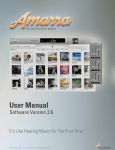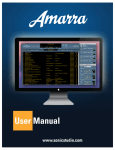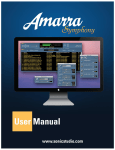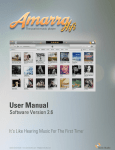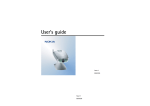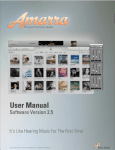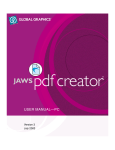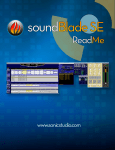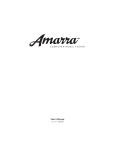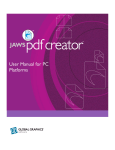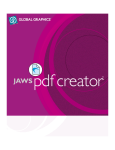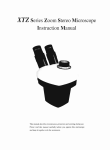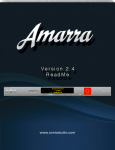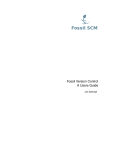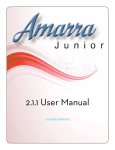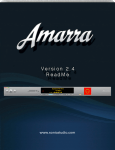Download Amarra_Symphony_v26_..
Transcript
Amarra Symphony with iRC v2.6 User Manual Table of Contents About This Manual Notice of Liability Notice of Rights 1.0 Welcome to the World of Amarra Symphony with iRC 2.0 Getting Started 2.1 Connecting to your output device 2.2 Launching Amarra Symphony the First Time 2.3 Launching Symphony Next Time 3.0 The Amarra Symphony Horizontal User Interface 1) Transport buttons 2) Symphony Volume Slider 3) Amarra Symphony UI Window 4) Playback Position Slider 5) Playlist Commands - only visible when in Playlist mode* 6) Artwork window 7) ‘M’ Button 8) ‘I’ Button - Information Button 9) CACHE Button 10) Amarra/iTunes Button 11) PLAYLIST Button 12) TRACKS Button 13) EQ Button 14) iRC Button 15) ‘P’ Button - Preload Tracks Button 16) LINK Button 17) Up/Down Arrow Button 3.1 The Amarra Symphony Vertical Window 4.0 Basic Music Playback from your iTunes library 5.0 Additional Features to Further Improve your Sound 5.1 Amarra Playlists 5.1.1 General Information about Amarra Playlists 5.1.2 Amarra Playlist Window 5.1.3 Entering Playlist Mode 5.1.4 Loading tracks into a Playlist 5.1.5 Using your Amarra Playlist 5.1.6 Saving a Playlist for Future Recall 5.1.7 Opening an Existing Playlist 5.1.8 Clearing your Playlist 5.2 CACHE Mode 5.3 Amarra EQ 5.3.1 Displaying the EQ Window 5.3.2 Turning the EQ On 5.3.3 Adjusting EQ 5.3.4 Setting Amarra EQ via iTunes 5.3.5 Saving and Recalling EQ Settings 6.0 Playing FLAC Files 6.1 Playing FLAC Files Natively via Amarra Playlists 4 4 4 5 6 6 6 7 8 8 8 8 8 8 8 9 9 9 9 9 9 9 9 9 10 10 10 11 14 14 14 15 15 15 16 17 17 17 17 18 18 18 18 19 19 20 20 6.2 Playing FLAC Files from iTunes 6.2.1 Converting FLAC Folder to AIFF Format 6.2.2 Converting FLAC Files to AIFF Format 7.0 Gapless Playback 7.1 Gapless Playback in Amarra/iTunes Mode 7.2 Gapless Playback in Amarra Playlist mode 8.0 Sample Rate Conversion using Sonic Studio Process 8.1 Launching Sonic Studio Process 8.2 The Params Window 8.3 The Que Manager Window 9.0 Sonic Studio iRC - Impulse Response Correction 9.1 Using iRC Measure 9.2 Using Sonic Studio iRC 10.0 Meters Display 11.0 Full Sonic EQ 12.0 Panner Window 13.0 Licensing 2 machines with your Amarra Symphony License 14.0 Registering Your Amarra Symphony with iRC Software 15.0 Contacting Sonic Studio APPENDIX A - Amarra Pulldown Menus A.1 Amarra Symphony Pulldown Menu A.2 File Pulldown Menu A.3 Playlist Pulldown Menu A.4 Desk Window A.5 Windows Menu APPENDIX B - The Amarra Symphony Preferences Window B.1 LAUNCH SETTINGS B.2 PLAYBACK SETTINGS B.3 CACHE SETTINGS B.5 PROCESSING SETTINGS B.6 HARDWARE SETTINGS B.7 ADDITIONAL SONIC HARDWARE SETTINGS APPENDIX C - Your Amarra Symphony Folder 20 21 21 22 22 22 23 23 23 24 25 25 25 27 27 28 28 29 30 31 31 32 33 34 34 35 35 35 35 36 36 37 38 About This Manual This manual, as well as the software described in it, is furnished under license and may only be used or copied in accordance with the terms of such license. The information in this manual is furnished for informational use only, is subject to change without notice, and should not be construed as a commitment by Sonic Studio, LLC. Sonic Studio, LLC assumes no responsibility or liability for any errors or inaccuracies that may appear in this book. Except as permitted by such license, no part of this publication may be reproduced, stored in a retrieval system, or transmitted, in any form or by any means, electronic, mechanical, recording, or otherwise, without the prior written permission of Sonic Studio, LLC. Notice of Liability The author and publisher have made every effort to ensure the accuracy of the information herein. However, the information contained in this document is provided without warranty, either express or implied. Neither the authors, Sonic Studio, LLC, nor its dealers or distributors will be held liable for any damages to be caused either directly or indirectly by the instructions contained in this book, or by the software or hardware products described herein. SONIC STUDIO, LLC MAKES NO WARRANTIES, EXPRESS OR IMPLIED, INCLUDING WITHOUT LIMITATION THE IMPLIED WARRANTIES OF MERCHANTABILITY AND FITNESS FOR A PARTICULAR PURPOSE, REGARDING THE APPLE SOFTWARE. SONIC STUDIO, LLC DOES NOT WARRANT, GUARANTEE, OR MAKE ANY REPRESENTATIONS REGARDING THE USE OR THE RESULTS OF THE USE OF THE SONIC STUDIO, LLC SOFTWARE IN TERMS OF ITS CORRECTNESS, ACCURACY, RELIABILITY, CURRENTNESS, OR OTHERWISE. THE ENTIRE RISK AS TO THE RESULTS AND PERFORMANCE OF THE SONIC STUDIO SOFTWARE IS ASSUMED BY YOU. THE EXCLUSION OF IMPLIED WARRANTIES IS NOT PERMITTED BY SOME STATES. THE ABOVE EXCLUSION MAY NOT APPLY TO YOU. IN NO EVENT WILL SONIC STUDIO, LLC, ITS DIRECTORS, OFFICERS, EMPLOYEES, OR AGENTS BE LIABLE TO YOU FOR ANY CONSEQUENTIAL, INCIDENTAL, OR INDIRECT DAMAGES (INCLUDING DAMAGES FOR LOSS OF BUSINESS PROFITS, BUSINESS INTERRUPTION, LOSS OF BUSINESS INFORMATION, AND THE LIKE) ARISING OUT OF THE USE OR INABILITY TO USE THE SONIC STUDIO SOFTWARE EVEN IF SONIC STUDIO HAS BEEN ADVISED OF THE POSSIBILITY OF SUCH DAMAGES. BECAUSE SOME STATES DO NOT ALLOW THE EXCLUSION OR LIMITATION OF LIABILITY FOR CONSEQUENTIAL OR INCIDENTAL DAMAGES,THE ABOVE LIMITATIONS MAY NOT APPLY TO YOU. Notice of Rights ©2007-2013 Sonic Studio, LLC — All rights reserved. No part of this document may be reproduced, stored in a retrieval system or transmitted in any form or by any means, without the prior written permission of the publisher. Sonic Studio, Amarra, Amarra Hifi, Amarra Symphony, Sonic Mastering EQ, Model 302, Model 303, Model Four, Model 305 and the Sonic Studio and Amarra logos are trademarks of Sonic Studio, LLC. All other company or product names are either trademarks or registered trademarks of their respective owners. Page 4 1.0 Welcome to the World of Amarra Symphony with iRC Congratulations and welcome to the Amarra family. By now you should have successfully downloaded, installed and activated Amarra Symphony with iRC (‘Symphony’) and are ready to listen to your music! We have a few short notes to pass along to make your listening experience better. • If you haven’t Installed and Activated Symphony yet, please do the following: - Double-click on the Amarra Symphony Installer Package to launch the installer - Follow on screen instructions for installation - Enter system admin password when prompted - Symphony will auto launch as part of installation • If you have any issues Activating Symphony, please refer to the Amarra Symphony Activation Guide located in your Amarra Symphony folder in Finder. If problems persist, please contact us at [email protected] • Google Translate now provides for translating full documents into local languages. Please visit http://translate.google.com/ , select the desired language to translate to and click on ‘translate a document’. It’s not a perfect tool, but it may help those who prefer languages other than English • Always launch Symphony first and let it launch iTunes to ensure proper operation •DO NOT adjust the sample rate in Audio Midi Setup or set your DAC’s sample rate manually to match the sample rate of the file. Symphony will automatically set both Audio Midi Setup and your DAC correctly to match the native sample rate of the file being played back. • If Symphony quits unexpectedly for any reason, please delete your Amarra Symphony Preferences prior to re-launching Symphony. See Appendix B for information on Amarra Symphony Preferences. •A significant amount of additional information can be found at our support portal and on our FAQ. Please visit our support page at http://www.sonicstudio.com/amarra/amarrasupport.html to access these resources. • Holding the Mouse over any button will display a Help Tip displaying what the button does. It’s time to Enjoy the Music!! Page 5 2.0 Getting Started This section reviews the initial steps needed to ensure proper operation of Amarra Symphony. 2.1 Connecting to your output device Ensure you have correctly set up the device you are sending your music to (built in audio, external DAC) by selecting the desired device in Audio Midi Setup and setting it to be the device for sound output (and sound input if available). You can access Audio Midi Setup in the Applications->Utilities folder in Finder. As an alternative, you can set the output device using the Sound item on the System Preferences window. NOTE: The table below reflects the sample rates supported by Symphony for the various interfaces connecting your Mac to your DAC/Output device. Remember that Symphony does not do any realtime up or downsampling as we believe this to be an audiophile no-no that results in non-bit-perfect, potentially inconsistent output. Ensure your DAC supports the desired sample rates natively and you should be all set. Amarra/DAC Sample Rate Support Once you’ve correctly set the device for sound output, you are ready to launch Amarra Symphony. 2.2 Launching Amarra Symphony the First Time As part of the installation process you will be asked if you want an Easy Setup and to launch Amarra Symphony. Click ‘OK’ for Easy Setup and select ‘Yes’ when prompted and Symphony will launch as the installation process completes. If this is a fresh install, you’ll need to activate your license with your code, email and a password you create up to 16 characters long. Enter that information, click Activate to launch Symphony. Symphony should find your sound output Page 6 device automatically while it launches Symphony and iTunes. You can verify the device Symphony is talking to by clicking on the ‘I’ button on the Symphony User Interface. Your device should be displayed in the Symphony UI window. 2.3 Launching Symphony Next Time After initial launch, to launch Symphony in the future, click on the Amarra Symphony icon in your dock or navigate to your Applications->Amarra Symphony folder in Finder and doubleclick on ‘Amarra Symphony.app’. As long as your device is set as the device for sound output prior to launching Symphony, Symphony should automatically find the device. Page 7 3.0 The Amarra Symphony Horizontal User Interface Symphony has 2 different User Interfaces available, one horizontal and one vertical. The horizontal user interface is the default UI and is shown below. To swap to the vertical UI, select Use Vertical Window in Amarra Symphony Preferences and restart Symphony. To swap back, deselect Use Vertical Window in Amarra Symphony Preferences and re-start Amarra. 1 2 7 8 9 10 3 11 4 12 13 14 5 6 15 16 17 Amarra Symphony Horizontal User Interface 1) Transport buttons << Go to head of current track, doubleclick to go to previous track ||/> Pause/Play button >> Go to next track 2) Symphony Volume Slider •Adjusts volume for Symphony playback. If you are using an external device, we recommend leaving the Symphony volume at full volume (all the way to the right) and use your volume control on your external device to adjust playback volume. •The speaker icons are hot spots for 0, and -144 dB. •iTunes and Amarra Symphony Volume are kept in sync. NOTE: You may notice a small delay or echo while the iTunes Volume is being moved. 3) Amarra Symphony UI Window •Displays Track, Artist and Album Name •Displays Gain level in dB (0.0dB to -144dB). •If Cache selected - Displays amount of RAM used to load selected tracks •Displays file type •Displays sample rate of current track •Displays position of Playhead via counter •If Preload Tracks Preference set - Displays track playing and tracks loaded •If EQ is on - Displays current EQ setting NOTE: If Gain is less than 0.0,dB dithering is enabled if auto-dither is selected in Amarra Symphony Preferences. 4) Playback Position Slider •Blue Slider corresponds to current playback position and can be moved either direction to reposition the playhead for playback. 5) Playlist Commands - only visible when in Playlist mode* See Section 5 for more details on using Amarra Symphony Playlists. Add: Adds selected tracks from iTunes into your Symphony Playlist Finder: Opens a Finder window to navigate to and select files to add to an Amarra Symphony Playlist Clear: Clears Playlist. Also clears preloaded tracks when in Symphony/iTunes mode Open: Opens a saved Amarra or Symphony Playlist - clears current playlist Save: Opens a Finder window to save current Playlist for future recall * Clear Button is visible in Amarra/iTunes mode and clears any Preloaded Tracks 6) Artwork window Page 8 •iTunes in yellow indicates iTunes is playing back your music. •Displays available artwork •Double-click on the Artwork window to open a larger, independent Artwork window NOTE: Not all tracks contain artwork. Use the Get Album Artwork command in iTunes to get additional artwork. NOTE: Amarra Symphony stores artwork in your Macintosh HD/Library/Applications Support/Sonic Studio/Artwork folder in Finder. If you are missing artwork, ensure you have proper permissions for this folder. 7) ‘M’ Button •Click to display Sonic Meters in the Symphony UI 8) ‘I’ Button - Information Button •Click to display your device information in the Symphony UI. This is a good way to validate what device Symphony is outputting music to. NOTE: A great way to do an A/B comparison between Symphony and iTunes is to simply toggle the Amarra/iTunes button. 11) PLAYLIST Button •Enters Amarra Playlist mode and sets your Amarra Playlists as the source for your music. NOTE: When in Playlist Mode, Symphony is ALWAYS playing your music back. 12) TRACKS Button •Active in both Amarra Playlist mode and when using Preload Tracks in Amarra/iTunes mode. Indicates the track being played back and the total tracks in your Playlist or that are preloaded. 13) EQ Button 9) CACHE Button •Turns the Equalizer window on and off. •Use Option-click to Bypass EQ •Preloads tracks into RAM to minimize disk access and improve performance NOTE: This button only effects the display of the EQ window. Use the EQ button on the Equalizer to turn the EQ on and off. •Available in both Amarra/iTunes and Playlist modes 14) iRC Button •Toggle button to turn Cache On and Off 10) Amarra/iTunes Button •Toggles the Amarra iRC window on and off 15) ‘P’ Button - Preload Tracks Button •Indicates the engine being used to playback music from your iTunes library. •Toggles the Preload Tracks function on and off •Amarra in blue indicates Symphony is playing back your music Page 9 16) LINK Button •Links the Symphony UI to the iTunes window. Move your iTunes window and Amarra will follow. NOTE: If you move your Amarra window, iTunes does not follow. This is useful if you need to temporarily separate the windows. 17) Up/Down Arrow Button •Toggles the Artwork Window on and off 3.1 The Amarra Symphony Vertical Window The Amarra Symphony Vertical Window is accessible via the Amarra Symphony Preferences window. Simply click on Amarra Vertical Window and restart Symphony to use the Vertical window. Amarra Symphony Vertical Window with iTunes Page 10 4.0 Basic Music Playback from your iTunes library Playing music using Amarra Symphony is a very simple process. Once you launch Symphony, you should see both the Symphony UI and your iTunes library on the screen. Amarra provides seamless integration with Apple’s iTunes program allowing you to manage and access all of your music through either the main iTunes Music Library or through custom Amarra Playlists. Use iTunes like you always have, select the songs / Playlists and hit play. Amarra will automatically set your DAC to match the native sample rate of the file, update Audio Midi Setup and begin playback of any track it can in your current environment. If Symphony encounters a track it cannot play, such as a protected file or a track with an unsupported sample rate for the current environment, it will seamlessly switch to iTunes for playback and then switch back to Symphony when it sees a track it can play without issue. NOTE: If you don’t see the Amarra window, it is likely behind your iTunes window. Make your iTunes window smaller (or exit Full Screen Mode) and you should find the Amarra window on screen. Use the ‘link’ button on the Amarra UI or choose Link Amarra window to iTunes in Amarra Symphony Preferences to link the Amarra and iTunes windows together. NOTE: Amarra plays most compressed files including FLAC, MP3, AAC, and Apple Lossless (ALAC). Amarra does not play some variable bit rate or low bite rate MP3 files. You can verify that Amarra Symphony is playing back your music by seeing the Amarra button turn blue on the Amarra Symphony UI. If the button has turned yellow and displays ‘iTunes’, it means that Symphony has passed control to iTunes for playback of the current track. Symphony will automatically take over playback on the next track that it can play back natively. Page 11 4.1 Navigating within a Track There are many ways to navigate within a track. Once you’ve started playback, you can: • Use the Transport buttons to Play/Pause and move to the next track, beginning of current track or previous track • The blue Playhead slider in the Amarra UI is a song position slider that corresponds to the current location of playback within a track. Drag the slider left or right to change the playback position within a track •Use the iTunes Playhead slider to move to a different location in the current track. •Modify the Time Display in the Amarra UI • Pause playback • Double-click on the Time element you want to modify. • Type in a new value and hit Return or • Click on a time element and drag your mouse left/right or up/down to modify • Click Return to save the new setting • Hit the Space bar or Play button to continue playback from the new location. NOTE: KEYBOARD SHORTCUTS - Use the following key commands in place of menu commands. Cmd+5, 6 Previous Track/Next Track Cmd + 8,9 Down/Up Volume Cmd + , Opens Preferences Window Cmd + HHide Amarra Cmd + Option + H Hide Others Cmd + QQuit Amarra File Menu Cmd + 1 Toggle Amarra/iTunes for Playback Cmd + 2 Toggles Playlist for Playback Option + CClears Tracks Cmd + Option + M Mute Cmd + E Eject Disk Playlist Menu Cmd + Shift + I Cmd + O Cmd + Option + C Option + P Add Tracks from iTunes Add Tracks from Finder Clear Tracks Opens Playlist Window Page 12 Desk Menu Cmd + Option + M Cmd + Option + C Mute Toggles Cache On/Off Windows Menu Option + AOpens Amarra Window Option + I Opens iTunes Window Option + P Opens Playlist Window Option + E Open EQ Window Option + R Opens Sonic IRC window Page 13 5.0 Additional Features to Further Improve your Sound Amarra has many features that can be used to further improve your sound over using just the basic Sonic Studio Engine built into Amarra. The following sections review the additional features and what they do to improve sound. NOTE: There are many suggestions on our FAQ for configuring your Mac for best performance. Please visit our website for access to the FAQ. For Optimal Sound Quality in Amarra Symphony, we recommend: • Use CACHE Mode and select Memory Amount to about 1/3 to 1/2 of available memory, up to 3Gb. • Load your Tracks into a Playlist and Quit iTunes. • In Amarra Symphony Preferences select Gain Bypass and use your external device for gain control • In Amarra Symphony Preferences, select EQ Bypass if not using EQ • From the Amarra->File->Extras pulldown menu, select Quit/Launch Finder to quit Finder 5.1 Amarra Playlists Amarra Symphony and Playlist windows Using Amarra Playlists provides several benefits including: • Processing your music more efficiently than in Amarra/iTunes mode resulting in better sound quality *Ability to run independently of iTunes • Ability to play FLAC files natively, no conversion needed 5.1.1 General Information about Amarra Playlists • You can load tracks of different sample rates and different file types into the same Playlist without issue. • Tracks can reside in more than one Playlist. • Amarra Symphony only stores a pointer and some other information about the file, it does not make an additional copy of the file when adding to a Playlist Page 14 • If you move your tracks to another location on your disk, you will need to re-do your Amarra Playlists • Commands for Amarra Playlists can be accessed from the Amarra UI, the Amarra Playlist UI or from the Amarra Symphony->Playlist pulldown menu. •You will only be able to load tracks into an Amarra Playlist that Symphony can play back in the current configuration. If you get a ‘sample rate not supported’ message, please check to make sure your Mac, interface and DAC all support the sample rate of the track being loaded. •You can also use a drag/drop method of loading tracks, including saved Amarra Playlists, into your Amarra Playlist from either your iTunes library or a Finder window. 5.1.2 Amarra Playlist Window Amarra Playlist mode provides an additional, independent Playlist window (optional) to manage your Amarra Playlists. There are some new buttons on the Amarra Playlist window to be aware of. The Link Button: This button links the Amarra window to the Amarra Playlist window. As you move the Amarra window, the Playlist window will follow. The Repeat Playlist Button: This button has 2 states and determines what Symphony should do at the end of a Playlist. Stop at end of Playlist: Repeat Playlist: All other buttons on the Amarra Playlist UI have the same function as on the Amarra UI. 5.1.3 Entering Playlist Mode Entering Playlist mode is easy. Simply press the Playlist button on the Amarra UI. The button will turn blue and typically the Playlist window is displayed. If you do not see the Playlist window, click on the Amarra Symphony->Windows->Playlist pull down menu item at the top of the screen. The PLAYLIST BUTTON: 5.1.4 Loading tracks into a Playlist There are 2 ways to load new tracks into an Amarra Playlist - selecting tracks from your iTunes library or selecting tracks via Finder. Page 15 The ADD Button: To select tracks via your iTunes library, please do the following: • Bring your iTunes window to the front and select the desired tracks in iTunes. You can use the command key and shift key to select individual tracks or a range of tracks. • Click on the Amarra UI to bring Symphony to the front • Click on the “ADD” button. The selected tracks in iTunes will load into your Amarra Playlist. The FINDER Button: To select tracks using the Finder, please do the following: • Click on the Finder button on the Amarra UI • Navigate to the tracks you’d like to load in the resulting Finder window. • Highlight the desired tracks and click ‘Open’ to add the tracks to your Amarra Playlist NOTE: Native FLAC File Playback: Use the Finder button to load your FLAC files natively into an Amarra Playlist. Navigate to your desired FLAC files, select and click ‘Open’ to add to your Playlist. TIP: By using Preload Tracks, you can Preload the desired number of tracks or an entire album into an Amarra Playlist by selecting just one track. 5.1.5 Using your Amarra Playlist Choosing Tracks in your Playlist You can select tracks in your Playlist by doing any of the following: • Select the track with your cursor and hit Play • Use the up or down arrow to move up and down in the Playlist • Use the >> and << Transport buttons on the Amarra UI to move to the next track, to the head of current track or to the previous track You can also use the Tracks Button to see the list of tracks loaded and to choose a desired Track The TRACKS BUTTON: Pulldown menu of the tracks either in your Amarra Playlist or Preloaded if in Amarra/ iTunes mode Deleting Tracks You can delete a track in the current Playlist by highlighting the track and hitting the Delete Key on your keyboard Moving Tracks You can move tracks up and down in the current playlist by highlighting the track and holding the mouse key down. You will see a white line that you can move around in the Playlist and it indicates where the file will be placed when dropped. Release the mouse to drop the file in place. It will take Symphony a moment to rebuild the Playlist so please be patient. Page 16 5.1.6 Saving a Playlist for Future Recall You can Save your Amarra Playlist for recall at a future time by using the Save button on the Amarra UI, on the Amarra Playlist UI or from the Amarra Symphony->Playlist pulldown menu. The SAVE Button: • Press the Save button • Set the desired name for the Playlist • Click the Where pulldown item to navigate to the desired location for your Playlist • Saving a Playlist with the same name and location will overwrite the existing Playlist 5.1.7 Opening an Existing Playlist You can recall an existing Amarra Playlist in one of 2 ways. You can either use the Open Button on the Amarra UI or drag/drop an existing Playlist into the Amarra Symphony Playlist Window. The Open Button: • Click on this button to access a Finder window. • Navigate to your saved Playlist and click Open to load into Amarra Playlists OR • Drag/Drop an existing Playlist from the Finder window into the Amarra Playlist Window. NOTE: Loading a new Playlist will clear any tracks currently in your Amarra Playlist. 5.1.8 Clearing your Playlist To clear the contents of your current Playlist simply click on the Clear Button: The Clear or Clear All Button: • Click on either button to clear the current contents of your Amarra Playlist • The Clear button also clears any Preloaded Tracks in Amarra mode. 5.2 CACHE Mode The CACHE Button: Cache mode pre-loads songs into RAM to minimize disk access resulting in better sound quality. Cache can be used in either Amarra/iTunes or Amarra Playlist Mode. To turn on Cache mode, simply click on the CACHE button on the Amarra UI prior to loading your tracks. The CACHE button will turn yellow and Amarra will first load your tracks into RAM and then begin playback. The amount of RAM used for loading your tracks is displayed in the Amarra UI Window, playback can begin once the amount of RAM is displayed. Choose the amount of RAM to use for CACHE Playback via the Amarra Symphony Preferences window, Memory Amount item. Note: Currently Amarra will load a max of 2.8 Gb into Cache, typically between 2.6-2.8Gb depending on the track being loaded. Amarra will only load complete tracks into CACHE. NOTE: Set Memory Amount to 1/3 to 1/2 of the available RAM on your machine for best performance. Page 17 5.3 Amarra EQ Note: Amarra Symphony Users also have access to the Sonic Mastering EQ via the Amarra Preferences window. Please see Appendix C for details on the Sonic Mastering EQ This section presents an overview of the Amarra EQ. Use the Amarra EQ to alter the sonic characteristics of the sound. Amarra provides three parametric filters to tailor your sound. All processing is done using 64bit floating point arithmetic. The parametric filters are classic, three parameter versions, with Resonant Frequency, gain, and Q. Q or Quality Factor is defined as the resonant frequency, or center frequency in the case of a symmetrical filter, divided by the bandwidth. The bandwidth is, in turn, defined as the one or two frequencies at which the filter response is 3 dB up or down from unity gain. Expressing the width of a filter as a Quality Factor, rather than bandwidth, provides a more intuitive sense of the filter’s subjective “sound,” since the same value of Q will produce different bandwidths at different frequencies. The higher the frequency, the wider the bandwidth will be for a given Q value, which roughly corresponds to our auditory mechanism’s ability to perceive a filter’s action. As an example, a parametric filter with a Q of 1 has a bandwidth of 100 Hz when its center frequency is set to 100 Hz but, it has a bandwidth of 1000 Hz when the center frequency is set to 1000 Hz. Using the EQ takes 2 steps - first display the EQ window and then turn the Equalizer itself on. 5.3.1 Displaying the EQ Window Click on the EQ button on the Amarra UI, below the center window. Use Option-Click on the EQ button to bypass current EQ settings. 5.3.2 Turning the EQ On Either click on the EQ button in the Amarra EQ window or choose one of the many presets available from the pulldown menu. 5.3.3 Adjusting EQ Choose one of the presets available or manually adjust the values in any of the 3 parametric filters by either moving the appropriate slider or typing the value in for Frequency, Gain and Q factor. Page 18 Amarra EQ Window 5.3.4 Setting Amarra EQ via iTunes • Select the ‘Link Amarra EQ to iTunes EQ’ in Amarra Preferences • Either set the iTunes global EQ or Select a Track in iTunes and using “Get Info” select the “Options”Tab and set the EQ Preset. Amarra EQ will follow the iTunes EQ presets. NOTE: A new feature in Amarra 2.5 is an Amarra Preference - ‘EQ Bypass’. This bypasses any EQ processing by Amarra during playback. Note: The iTunes EQ is typically ‘On’ by default which may effect playback even if the ‘Link Amarra EQ to iTunes EQ’ preference is not selected. We recommend turning the iTunes EQ ‘Off’ unless specifically using the iTunes EQ. The iTunes EQ can be accessed from the iTunes>Windows menu. 5.3.5 Saving and Recalling EQ Settings The Amarra->Desk menu items allows you to save and recall your EQ settings. •Set your EQ Settings •Go to the Desk menu and select Save Sonic EQ Setup to save your settings •Use Open Sonic EQ Setup to open an existing EQ saved setting •To save a new ‘DEFAULT’ setting: •Set the EQ Preset menu to Default •Make your desired adjustments to the Freq, dB and Q parameters •From the Amarra->Desk pulldown menu, click on ‘Save as Default’ •If you quit with the Default EQ setting set, next time you launch, those values will be automatically recalled NOTE: You will need to click on the top bar of the Amarra EQ to make the EQ the Active Window for the Amarra Desk menu items to be accessible. Page 19 6.0 Playing FLAC Files Amarra Symphony provides 2 means of playing back FLAC files - natively from an Amarra Playlist and a converted file in your iTunes library. In addition, Amarra has built-in FLAC to AIFF file conversion to allow easy integration with your iTunes Library. Why convert FLAC to AIFF? • Easy integration with iTunes • Integration with iTunes Metadata • Integration with Apple Remote • Simplified ease of us (convert and forget) • Less overhead on system resources. 6.1 Playing FLAC Files Natively via Amarra Playlists Amarra provides for FLAC file playback natively via the PLAYLIST function, without using iTunes. To playback FLAC Files via Amarra Playlists, do the following: • Obtain your music in FLAC format from one or more of a variety of providers such as HD Tracks among others. As part of the download process, please note where your music is being downloaded to. Once the download completes (this may take some time depending on the number and size of the tracks being downloaded), move on to step 2. • Go into Playlist Mode (see chapter 5.1 about using Playlists). You can either Drag/Drop your FLAC Files into the Playlist window, use the Finder button in either the Amarra UI or the Playlist UI or select Open Tracks via Finder from the Amarra Symphony->Playlist pulldown menu. If using the Finder window • Navigate to your FLAC files, highlight the desired tracks. Note: The Finder window supports both the shift and command keys for making multiple selections. •Once you are done making your selection(s), click on the Open button to add the files to your playlist. Continue adding songs until you are satisfied with your playlist. Select File > Save Playlist to save your playlist, giving it a meaningful name and saving it in a memorable location. • To play your playlist, just click on Amarra’s Play button. You can skip forward and back in the playlist by using the forward and back buttons, using the Tracks list or by clicking on the desired track in the Playlist window. 6.2 Playing FLAC Files from iTunes iTunes does not natively support FLAC Files. Your files will need to be converted to a format supported by iTunes in order to be loaded into your iTunes library. Under the Amarra Symphony->FILE Menu there are two commands available for this function. You can convert either selected FLAC files or an entire FLAC folder to AIFF format. You can also automatically add them to your iTunes library and create an iTunes playlist. Page 20 6.2.1 Converting FLAC Folder to AIFF Format Converting a FLAC Folder to AIFF is an easy 3-step process • Click on the Amarra Symphony->File->Convert FLAC Folder to AIFF • In the resulting Finder window, navigate to and select the folder containing FLAC files you want to convert and click Open. • In the next window, specify the destination folder for the new AIFF files. You can create a temporary folder for this or choose an existing folder for your new AIFF files. Click Open when done. • Lastly, you will have the opportunity to automatically add these files to iTunes and create a playlist using the dialog below. This will copy (and organize if your iTunes Preferences are set) with your iTunes library. 6.2.2 Converting FLAC Files to AIFF Format Converting a FLAC FILE to AIFF is an easy 3-step process • Click on the Amarra Symphony->File->Convert FLAC FILE to AIFF • In the resulting Finder window, navigate to and select one or more FLAC files to convert and click Open • In the next window, specify the destination folder for the new AIFF files. • Lastly, you will have the opportunity to again, automatically add these files to iTunes and create a playlist. NOTE: Converting FLAC Folders and Files to AIFF using Amarra Symphony is a non-destructive process. Your original FLAC files will remain intact and you will also have new AIFF files. We recommend copying your FLAC files off to your backup drive for retrieval in case of emergency. Use your AIFF files for day-to-day playback. This setup will provide better sound quality during playback and minimize the amount of space needed for backups. Page 21 7.0 Gapless Playback Gapless playback is perfect for contiguous performances such as symphonic recordings or live, continuous performances. Gapless playback is now available in both Amarra/iTunes mode and in Amarra Playlist mode however there are some minor differences between how gapless playback is provided in each mode. NOTE: Uncompressed files are required for Gapless Playback. Use AIFF, WAV, or BWF files 7.1 Gapless Playback in Amarra/iTunes Mode To enable Gapless Playback in Amarra/iTunes Mode: • Select the Amarra Symphony Preference setting for PRELOAD TRACKS and set the COUNT parameter to the desired number of tracks (or a full album) in the gapless performance. • Ensure your iTunes library is sorted in the correct order in SONG view for the gapless performance. • Choose a track in iTunes and the number of tracks in the COUNT field will be loaded together, based on current sort order, and played back. Those tracks that are part of a true gapless performance will be played back without a gap. NOTE: The current sort order of your iTunes library is critical for gapless playback, especially when attempting to Preload and play a full album. Please ensure your iTunes library is sorted in the correct order when in Songs or List View prior to attempting to Preload Tracks. For best performance, when Preloading an Album, sort your iTunes library by ‘Artist by Album’. When Preloading a specified number of tracks, Symphony will load tracks, based on current sort order, up to the specified number in Amarra Symphony Preferences or until the sample rate changes. NOTE: Please unsure that you have disabled SHUFFLE mode in iTunes when using PRELOAD TRACKS in Amarra Symphony 7.2 Gapless Playback in Amarra Playlist mode Using Amarra Playlists makes it very easy to have gapless playback. All tracks in an Amarra Playlist will play back gaplessly as long as the sample rate is the same, there is no need to set the PRELOAD TRACKS item in Amarra Preferences. That said, using the Preload Tracks function will allow you to load several tracks or an entire album by selecting only one track in iTunes. Note: Gapless Playback is designed to work with true gapless performances such as symphonic recordings, live performances and recordings that were mastered as gapless. Gapless playback is not a substitute for mixing independent tracks together. Note: For best performance, when Preloading an Album, sort your iTunes library by ‘Artist by Album’. When Preloading a specified number of tracks, Amarra will load tracks up to the specified number in Amarra Preferences or until the sample rate changes. Page 22 8.0 Sample Rate Conversion using Sonic Studio Process Sonic Studio Process provides the ability to up or down sample your uncompressed tracks offline and create new files that can be played back at new native sample rates. In addition, SSP allows for a change in file type as part of the sample rate conversion. For additional information, refer to the Sonic Studio Process User Manual located in your Applications -> Amarra Symphony -> Extras folder. 8.1 Launching Sonic Studio Process The Sonic Studio Process can be accessed from the Amarra Symphony->File pulldown menu. Choose Open Sonic Studio Process to launch Sonic Studio Process. 8.2 The Params Window When you launch Sonic Studio Process, you will be presented with a Params window which will allow you to add the source files you wish to convert (use the Open Button), the destination for your converted files (use the Set Folder button) and a series of parameters regarding the sample rate conversion. SSP Params Window Clicking the Execute button will start the conversion. Page 23 8.3 The Que Manager Window You can track the progress of your job by clicking on the Que Manager button to display the Que Manager window. SSP Que Manager Window A detailed description on using Sonic Studio Process can be found in SSP User Manual located in your Amarra Symphony->Extras folder. NOTE: There are several functions documented in the Sonic Studio Process Manual that are not available in Amarra Symphony, but are only available in our standalone, separately licensed Sonic Studio Process. These functions include: • Decrackle Process • Sample Rate support above 192k • CAF File type support • “Classic” Sample Rate Converter • Additional Filter curves and Dither Types Page 24 9.0 Sonic Studio iRC - Impulse Response Correction NOTE: New purchases of Amarra Symphony with iRC v2.6 include the Sonic Studio iRC feature. Amarra Symphony 2.5.1 and previous version upgrades to Amarra Symphony 2.6 do not include the Sonic Studio iRC feature. An upgrade to add this feature to your copy of Amarra Symphony is available on our online store. Apart from Sonic Studio iRC feature, current Amarra Symphony users get all of the bug fixes and additional features added to Amarra Symphony 2.6 free of charge. NOTE: You will need an omnidirectional full-bandwidth measurement microphone. We recommend that the frequency response is within ± 1 dB in the area of the speaker’s frequency response range. Failure to use a recommended microphone may result in false measurement information. The XTZ Microphone Pro from XTZ Audio is a cost efficient microphone kit that we recommend. Other recommended mics can be found in our FAQ. The listening room is usually the weakest link of any sound system. Loudspeakers have been designed for a certain placement in a room, but in an imperfect environment, performance suffers and it’s impossible get the full benefit from your DAC, amp and speaker investment. Imaging, clarity, and bass tightness are all affected by the limitations imposed by your listening room, and the result is that your listening experience can be significantly diminished. Amarra Symphony now includes Sonic Studio iRC Impulse Response Correction capability. This leading-edge room correction technology is designed to optimize the sound of your system in your environment and to your taste. Sonic Studio iRC measures the acoustic characteristics of your loudspeakers within your listening environment and then optimizes for timing, phase and frequency anomalies imposed by your room. The result is massively improved imaging and sound staging because now your room will be working with your sound system, not against it. Using Sonic Studio iRC is a 2 step process. First, measure and calibrate your listening environment using the iRC Measure calibration tool and create filter files (.filter suffix) for your specific needs. The second is to load the filter files into the Sonic Studio iRC filter bank in Amarra Symphony for use during play back. 9.1 Using iRC Measure The iRC Measure application (iRC Measure.app) is installed as part of the Amarra Symphony standard installation and can be found in your Applications->Amarra Symphony folder in Finder. Please refer to the Sonic Studio iRC User Manual for details on installing and using the iRC Measure application. The manual can be found in your Amarra Symphony folder. 9.2 Using Sonic Studio iRC Filter sets created by the iRC Measure application must be loaded into Sonic Studio iRC filter bank. The Sonic Studio iRC filter bank window is accessed by pressing the iRC button on the Amarra Symphony User Interface. Page 25 Pressing the button will launch the Sonic Studio iRC application, check for a valid license and display the Sonic Studio iRC filter bank (see image below). Remember to click the On/Off button on the filter bank to turn processing on and off. NOTE: Filter names in the Sonic Studio iRC window will be set automatically according to the ‘yournamehere.filter’ filename in Finder Sonic Studio iRC filter bank The SSiRC filter bank has four (4) pre-selection slots where filter files can be loaded for quick selection. To load a filter file into an empty slot: • Double-Click on an empty filter slot. This opens a Finder dialog where you can navigate to the folder where you stored your filter files using the iRC Measure application. • Select the filter file that you want to load from the popup Finder window. • Adjust Gain to an appropriate level for the filter you are using by typing a value in the box provided. NOTE: A value of 0.0 dB is full volume, positive numbers increase gain, negative numbers decrease gain. Putting a value above 0.0 in the gain field will increase your output signal, be careful when setting gain to avoid potential damage to your equipment. Listen to the result of applying the loaded filters by doing the following: • Play a track through Amarra Symphony. • Turn on the Sonic Studio iRC filter bank by pressing the on/off button until it reads On in blue. • Switch between loaded filters by clicking the corresponding filter slot. The active filter slot has a blue indicator. Note: Deleting Amarra Symphony Preferences will delete your pre-selected filters from Sonic Studio iRC, they will need to be reloaded. Page 26 10.0 Meters Display Amarra Symphony employs a high precision metering section to visibly display the audio signal. Select the “M” button to show the Meters. Amarra Symphony Track Area with Meters displayed Note: Meters will not be displayed when the ‘Bypass EQ’ Preference is selected 11.0 Full Sonic EQ Select the Amarra Symphony Preference ‘Full Sonic EQ’ to enable the advanced, full 4-band Equalizer. The Full Sonic EQ Preference changes the Equalizer from the Amarra EQ Window to the Full Sonic EQ window. A restart is required for this option to engage. Full Sonic EQ has Full 4-Band EQ. Types supported include : Notch, Low Pass, High Pass, and many more. Global Sonic EQ Window Page 27 12.0 Panner Window Amarra Symphony has a stereo panner that can be used to route the output with variable gain. To open the panner select Amarra Symphony->File-> Panner, which brings up the Panner window. The Panner in Stereo mode By default, the panner opens in off mode. In the upper left corner, the channel to which the panner currently applies is indicated. As this Track indicator is also a drop down menu, it operates as a Strip selector for the panner as well. 13.0 Licensing 2 machines with your Amarra Symphony License Amarra Symphony allows for 2 machines to be activated with the same license. To activate Amarra Symphony on two machines, please do the following: Machine 1 - Download and launch the Amarra Symphony Installer on Machine 1 - Choose Easy Setup - Select ‘Yes’ when asked to launch Amarra Symphony - Click Activate to access the Activation Window - Enter Your Activation Code, email address and create your own password up to 16 characters long and enter in the spaces provided. - Click ACTIVATE to activate your copy of Amarra Symphony on Machine 1. Machine 2 - Download and launch the Amarra Symphony Installer on Machine 2 - Choose Easy Setup - Select ‘Yes’ when asked to launch Amarra - Click Activate to access the Activation Window - Enter Your Activation Code, email address and the password created for machine 1 in the spaces provided - Click ACTIVATE to continue the process on Machine 2. - You will be asked to enter a new password for Machine 2. Enter in a new, unused password up to 16 characters in length. You should get a message that your software has been activated and should not have any issues moving forward. Note: Your password is attached to your license, not your computer. The password created on machine 2 will become the active password for your license should you need to activate any machine in the future. Page 28 14.0 Registering Your Amarra Symphony with iRC Software In order to receive warranty service, you must register your product with Sonic Studio. This may be done at any time with proof-of-purchase. We strongly recommend that you register with Sonic Studio as soon as you purchase your unit. Why? 1. Your product will be registered with us. Registration is used as proof of ownership if your product is ever lost or stolen. 2. Sonic Studio updates Amarra Symphony software on a regular basis. This allows us to keep you informed of updates as they become available. We strongly encourage you to create a License Control Panel Account. Please read the Amarra Symphony Activation Guide for information on this important feature. Please register your Amarra Symphony software using our automated registration Web page at: http://www.sonicstudio.com and click on Support => Register Alternatively, our mail address is: Sonic Studio, LLC Amarra Software Registration 1340 Mission Street San Francisco, CA USA 94103 If you encounter issues using Amarra Symphony please refer to our Amarra Support Portal at http://www.sonicstudio.com/amarra/amarrasupportportal.html. If none of these steps address your problem please contact your dealer or Sonic Studio support for more help. Page 29 15.0 Contacting Sonic Studio Thanks for using Amarra Symphony. We really appreciate your patronage and are always interested in your experiences with Amarra Symphony. For information on problems, resources please visit our FAQ page http://www.sonicstudio.com/amarra/amarrafaq.html For bug reports and support issues, visit: http://www.sonicstudio.com/amarra/amarrasupport.html or email us: [email protected] To suggest new features for our products, e–mail us at [email protected] Page 30 APPENDIX A - Amarra Pulldown Menus The following section describes the Amarra Symphony Pulldown Menu Items Amarra Symphony Menu Bar A.1 Amarra Symphony Pulldown Menu About Amarra: Opens the modal About window. This is useful for verifying the version number of Amarra Symphony that you are running. Click anywhere in the window to close it. Preferences: Opens the Preference window for Amarra Symphony. Services: This menu proves access to any Services that are available to Amarra Symphony. Hide Amarra: Hides all Amarra Symphony windows. To reveal the windows, click on the Dock icon or tap the ‚+tab key to cycle through running applications to select Amarra Symphony. Hide Others: Hides all windows other than Symphony. Show All: Reveals all windows. Quit Amarra: Quits Amarra Symphony. Page 31 A.2 File Pulldown Menu Toggle Amarra/iTunes Playback [cmd+1]: Toggles between Amarra Symphony and ITunes engine for playback in Amarra/iTunes mode. N/A in Amarra Playlist mode Set Playlist for Playback: [cmd+2]: Sets Amarra Symphony’s Playlist as the source for playback Open Recent: List of Recent Amarra Playlists for easy access Clear Tracks: Clears Tracks from either Amarra Playlist or Preloaded Tracks Mute: Mutes Amarra Symphony Convert FLAC File to AIFF... : Convert FLAC Files to AIFF Format - see chapter 6 for details Convert FLAC Folder to AIFF... : Convert FLAC Folder to AIFF Format - see chapter 6 for details Activation...: Opens the Activation Window, refer to the Amarra Activation Guide for more information about Activating Amarra Symphony Audio Device Preferences...: Opens the Audio Device Preferences for managing your DAC Open Audio Midi Setup...: Open the Audio Midi Setup window for setting up your DAC Panner - Amarra: Opens the Amarra Panner Window Open Sonic Studio Process...: Opens Sonic Studio Process for Sample Rate Conversion Check for Updates...: Manually checks for availability of new versions of Amarra Symphony. Setting the Amarra Symphony Preferences - Check for Updates on Launch will automate this Sonic Studio Website...: Links back to the Sonic Studio Website Eject Disk...: Ejects CD from tray Extras...: Accesses additional features of Amarra Page 32 Extras: submenu Close Window: NA Cut: NA Copy: NA Paste: NA Enable Debugging: Allows Amarra Symphony to log information on its operation to the Console Log. Open Console Log: Opens the Console Application to view the Amarra Symphony console log ( in Utilities Folder ). Quit/Launch Finder: Quits and launches the Finder Application Purge OSX Inactive Memory: Releases Inactive memory that OS has not released. This can help with overall play back performance. A.3 Playlist Pulldown Menu Add Tracks From iTunes [shft+cmd+i]: Adds tracks selected in iTunes into Playlist Add Tracks from Finder [cmd+o]: Select and add audio tracks from the Mac Finder. Clear Tracks: Clears the current Playlist or when used in Amarra/iTunes mode, clears any Preloaded Tracks Open Playlist...: Open an existing Amarra Playlist Save Playlist...: Saves a Playlist to disk for later recall Playlist Window...: Opens the Amarra Playlist window Page 33 A.4 Desk Window Open Sonic EQ Setup...: Allows you open a previously-saved Sonic EQ Setup. Save Sonic EQ Setup: Allows you to save the current (open) Sonic EQ Setup. Save As Default: Save the current (open) Sonic EQ Setup as the Default EQ. The Sonic EQ Setup will be recalled on launch. Mute [opt+cmd+M]: Turns Mute on and off. Cache [opt+cmd+M]: Turns CACHE Mode on and off. A.5 Windows Menu Amarra [opt+a]: Toggles the Amarra Window on and off iTunes [opt+i]: Toggles the main iTunes Window on and off Playlist: [opt+p]: Toggles the Amarra Playlist Window on and off Equalizer [opt+E: Toggles the Equalizer on and off Sonic iRC [opt+R: Turns on Sonic Studio iRC window Page 34 APPENDIX B - The Amarra Symphony Preferences Window This section describes all of the functions available via the Amarra Symphony Preferences window. NOTE: Deleting Amarra Symphony Preferences - if Symphony quits unexpectedly or if you are seeing any unusual behavior, try deleting your Amarra Symphony Preferences to see if this clears the issue • Quit Symphony and iTunes • Navigate to your Applications->Amarra Symphony->Extras folder in Finder • Double-click on ‘Delete Amarra Preferences.command’ • Re-launch Symphony when the process completes. Symphony will launch iTunes NOTE: By de-selecting the Amarra Symphony Preference item ‘Launch/Quit Amarra with iTunes’, you will stop iTunes from automatically launching when you launch Amarra. This is helpful if you wish to operate independent of iTunes, using Amarra Playlists to play your music. B.1 LAUNCH SETTINGS LAUNCH / QUIT ITUNES: Forces iTunes to launch or quit with Amarra Symphony. HIDE ON LAUNCH: Symphony will hide on launch. LINK AMARRA TO ITUNES WINDOW : Forces iTunes to remain ‘attached’ to Symphony’s main window LINK AMARRA EQ TO ITUNES EQ : Forces Symphony to follow the EQ settings in iTunes. CHECK FOR UPDATES ON LAUNCH: Amarra Symphony will check for updates on launch. OPEN PLAYLIST ON LAUNCH: Re-loads last used playlist on launch of Symphony VERTICAL WINDOW: Vertical window. (restart required) ------------------------------------------------- B.2 PLAYBACK SETTINGS PRELOAD TRACKS : Enables loading of multiple tracks in Amarra/ iTunes Mode. This provides gapless playback capability. COUNT : Number of tracks to load for gapless playback NOTE: Disable SHUFFLE MODE in iTunes when using PRELOAD TRACKS. ------------------------------------------------- B.3 CACHE SETTINGS MEMORY AMOUNT : Amount of RAM dedicated to store audio in Cache Mode. Settings are 512Mb, 1Gb, 2Gb and 3Gb. We recommend between setting this to between 1/3 and 1/2 of your available memory. Note: Currently Amarra Symphony will Page 35 load a max of 2.8 Gb and typically between 2.6-2.8Gb depending on the track being loaded. Symphony will only load complete tracks into CACHE. ------------------------------------------------- B.4 DITHER SETTINGS AUTO-DITHER: Automatically enables redithering when Amarra Symphony’s Volume is set to something less than full volume (0.0 dB). Setting Volume to full automatically disables dithering. TYPE : TPDF: Enables Sonic Studio’s Shaped TPDF Dither. Shaped: Enables Sonic Noise Shaped Dither Wordlength: Sets number of bits for output. This setting should match your DAC’s word length. For best quality enable Auto-dither. When dither is enabled the output of Amarra will be dithered to the setting of the Output Wordlength specified. This can be useful for providing a better sound when Gain is used or if your DAC only supports a limited word length (16 or 20 bits). NOTE: When the Output Wordlength is set to 24 bits the dither will be “disabled” if the Gain has not been modified (at full volume). Once the Gain is adjusted then dither is re-enabled. NOTE: Amarra Symphony provides two dither options: Sonic TPDF and Sonic’s advanced psycho-acoustic noise-shaped dither. Your personal experience may decide which one you prefer. ------------------------------------------------- B.5 PROCESSING SETTINGS FULL SONIC EQ: Allows access to the Full Sonic EQ Window, requires a restart of Amarra to take effect GAIN BYPASS: Bypasses all gain adjustments made in Amarra. Plays back tracks at full volume (0.0 dB) EQ BYPASS: Bypasses all Amarra Symphony EQ processing currently in effect. ------------------------------------------------- B.6 HARDWARE SETTINGS Follow Core Audio Settings: Automatically follow Core Audio Settings when changed. Symphony will use the same output device as specified in AMSU. De-select this Preference and use Audio Device Preferences to set your Output Audio Device to a different Audio Device, independently of AMSU. ------------------------------------------------- Page 36 B.7 ADDITIONAL SONIC HARDWARE SETTINGS Amarra Symphony provides additional preferences when used with a Sonic Audio Interface. These controls allow integration of Analog Gain Control and more. Additional Sonic Hardware Preferences NOTE: Requires Sonic Studio Hardware and the Amarra Console Software. Launch/Quit Console: Forces Sonic Console to launch or quit in sync with Amarra. Dim Front Panel: Dims the front panel display. Control Volume: Interlocks Amarra’s gain control with the hardware gain control so either can be used. Gain Adjustment: Set the system gain to match professional (0 dB) or consumer electronic (-10 or -14 dB) standard. Page 37 APPENDIX C - Your Amarra Symphony Folder This section describes the files installed in your Applications->Amarra Symphony folder in Finder as part of the Amarra Symphony installation process. Amarra Symphony.app: The Amarra Symphony application iRC Measure.app: Impulse Response Correction measurement and calibration tool Extras Folder: (these items run only when launched manually) • Amarra QuickSupport.app - remote login application used for remote support sessions • Amarra Remote.app - for use with the Mac’s Infared Remote Control • AmarraLicenseManager.app - use this app to manually manage backing up and removing your Amarra license •AmarraSymphonySetup.app - use this app to manually go through the Easy Setup process of the Amarra installation •Amarra FLAC Installer.pkg - use this Installer Package to manually install the FLAC components needed for FLAC file playback. These are automatically installed as part of the Easy Setup installation. •Sonic_Studio_Process_User_Manual.pdf - refer to this manual for details on operating Sonic Studio Process •Delete Amarra Preferences.command - use this utility to reset Amarra Symphony to a factory default setting •uninstall_amarra.command - use this utility to uninstall Amarra and remove Amarra related files from your disc •flac Folder - contains the 2 FLAC components needed for FLAC file playback. They are loaded into the Macintosh HD->Library->Components folder •Scripts Folder - contains scripts used during the installation of Amarra Symphony. Manuals: •Amarra Activation Guide.pdf - refer to this manual for Installation and Activation instructions •Amarra 2.6 Read Me.pdf - important notes about Amarra Symphony version 2.6 •Amarra Symphony 2.6 User Manual - refer to this manual for detailed information about operating Amarra Symphony •Amarra FAQ.webloc - link to our Amarra FAQ •Amarra - Support.webloc - link to the Amarra Support portal ©2007-2013 Sonic Studio, LLC — All rights reserved. No part of this document may be reproduced, stored in a retrieval system or transmitted in an form or by any means, without the prior written permission of the publisher. Sonic Studio, Amarra, and the Sonic Studio and Amarra logos are trademarks of Sonic Studio, LLC. All other company or product names are either trademarks or registered trademarks of their respective owners. Page 38






































